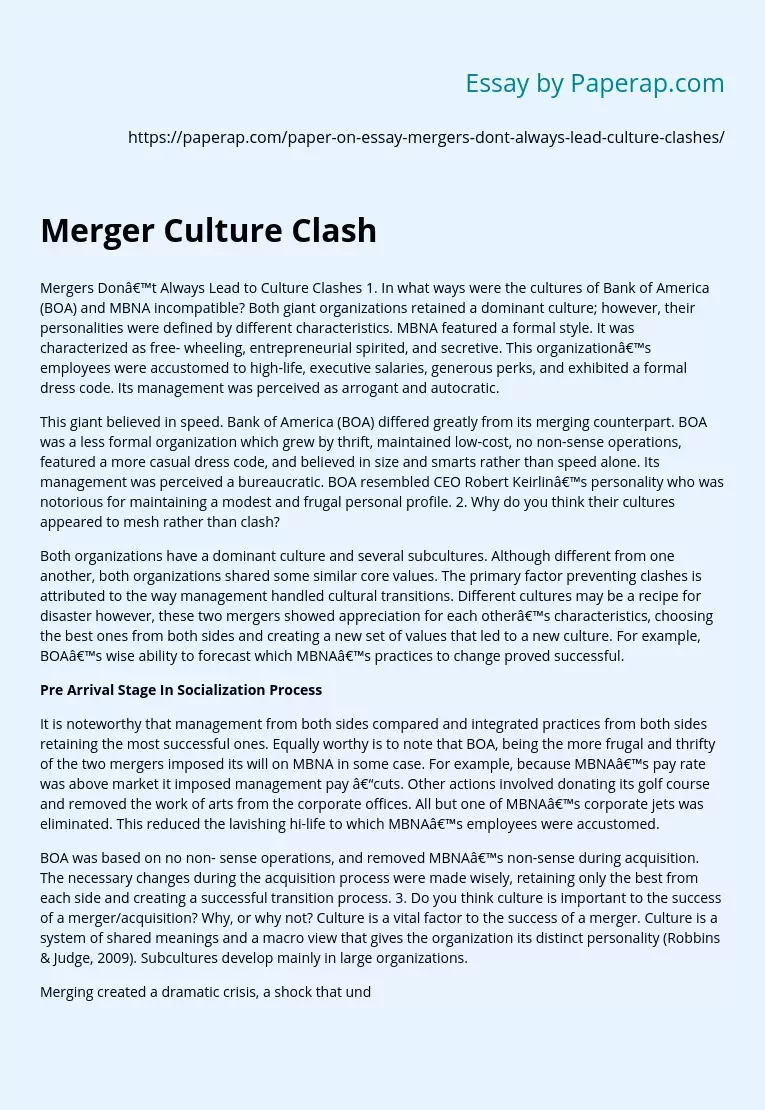Merger Culture Clash Issue in Companies
Mergers Don’t Always Lead to Culture Clashes
1. In what ways were the cultures of Bank of America (BOA) and MBNA incompatible? Both giant organizations retained a dominant culture; however, their personalities were defined by different characteristics. MBNA featured a formal style. It was characterized as free- wheeling, entrepreneurial spirited, and secretive. This organization’s employees were accustomed to high-life, executive salaries, generous perks, and exhibited a formal dress code. Its management was perceived as arrogant and autocratic.
This giant believed in speed.
Bank of America (BOA) differed greatly from its merging counterpart. BOA was a less formal organization which grew by thrift, maintained low-cost, no non-sense operations, featured a more casual dress code, and believed in size and smarts rather than speed alone. Its management was perceived a bureaucratic. BOA resembled CEO Robert Keirlin’s personality who was notorious for maintaining a modest and frugal personal profile. 2. Why do you think their cultures appeared to mesh rather than clash?
Both organizations have a dominant culture and several subcultures.
Although different from one another, both organizations shared some similar core values. The primary factor preventing clashes is attributed to the way management handled cultural transitions. Different cultures may be a recipe for disaster however, these two mergers showed appreciation for each other’s characteristics, choosing the best ones from both sides and creating a new set of values that led to a new culture. For example, BOA’s wise ability to forecast which MBNA’s practices to change proved successful.
Pre Arrival Stage In Socialization Process
It is noteworthy that management from both sides compared and integrated practices from both sides retaining the most successful ones.
Equally worthy is to note that BOA, being the more frugal and thrifty of the two mergers imposed its will on MBNA in some case. For example, because MBNA’s pay rate was above market it imposed management pay –cuts. Other actions involved donating its golf course and removed the work of arts from the corporate offices. All but one of MBNA’s corporate jets was eliminated. This reduced the lavishing hi-life to which MBNA’s employees were accustomed.
BOA was based on no non- sense operations, and removed MBNA’s non-sense during acquisition. The necessary changes during the acquisition process were made wisely, retaining only the best from each side and creating a successful transition process. 3. Do you think culture is important to the success of a merger/acquisition? Why, or why not? Culture is a vital factor to the success of a merger. Culture is a system of shared meanings and a macro view that gives the organization its distinct personality (Robbins & Judge, 2009). Subcultures develop mainly in large organizations.
Merging created a dramatic crisis, a shock that undermines the status quo of both organizations which must create a new culture and co- adapt. As the text relates, a unit that is physically separated from the main dominant culture will take on a separate personality (Robbins & Judge, 2009). Such is the case during an acquisition. Core values are retained but are modified to reflect the new personality. Strong culture builds cohesiveness and loyalty, and increases behavior consistency (Robbins & Judge, 2009). Culture is a liability when shared values are not in agreement.
The merger environment undergoes rapid change and the organization’s entrenched culture may no longer be effective, therefore it is important to facilitate a stable environment by introducing consistency of behavior. Culture is dependent on socialization of employees. According to the text, socialization involves a three step process: prearrival, encounter, and metamorphoses which in turn achieves the desired outcome which is productivity, commitment and turnover (Robbins & Judge, 2009). Strong culture will exert ethical influence on employees. Management must be visible role model and a benchmark for employees.
By defining clear sets of expectations management minimizes ethical ambiguities, emphasizing vitality and growth which is part of a strong culture (Robbins & Judge, 2009). 4. How much of the smooth transition, if any, do you think comes from both companies glossing over real differences in an effort to make the merger work? I believe that 100 percent of the smooth transition comes from both companies glossing over real differences in an effort to make the merger work. The barriers to acquisition and mergers were successfully removed because the management used an Investiture/Divestiture ocialization strategy. Divestiture socialization strategy involved trying to strip away some of the characteristics from the other company’s employees (Robbins & Judge, 2009). For example some of the materials symbols had been changed.
The attire was adjusted, executive perks reduced, and salaries adjusted accordingly. Investiture socialization supports some of the qualities found in an organization. Both strategies were maintained to create a general climate for both mergers. The success in this acquisition was based on the efforts to reach the value oals during acquisition stage. The primary reason for failure in merging is conflicting organizational cultures (Robbins & Judge, 2009). In this case the reward system was modified to support new values, current subcultures were undermined through elements such as transfers, job rotation, pressure to conform to an alternative set of key values. The two mergers reached metamorphosis stage and the general climate has changed.
References:
Robbins, S. P. ; Judge, T. A. (2009). Organizational behavior (13th ed. ) Upper Saddle River, NJ. Pearson/Prentice Hall
Merger Culture Clash Issue in Companies. (2019, Dec 05). Retrieved from https://paperap.com/paper-on-essay-mergers-dont-always-lead-culture-clashes/

